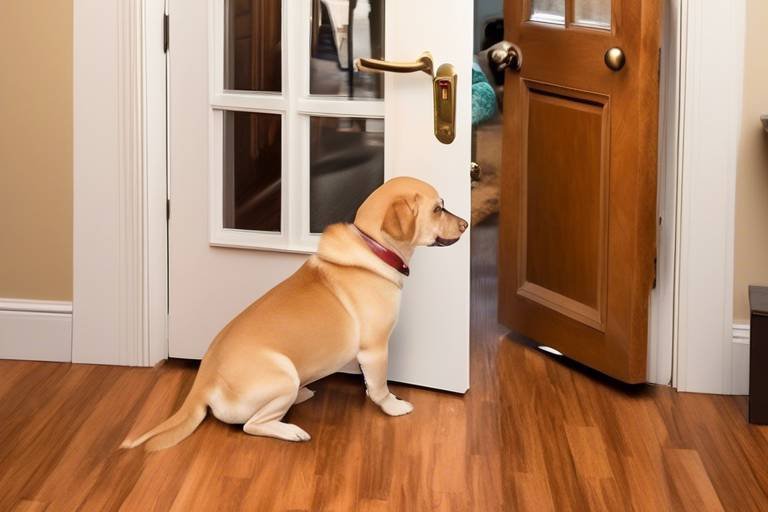How to Address Barking at the Doorbell
Does your dog turn into a barking machine every time the doorbell rings? You’re not alone! Many dog owners face this common issue, and it can be quite frustrating. The incessant barking not only disrupts your peace but can also make guests feel unwelcome. Luckily, there are effective strategies to manage and reduce this behavior, ensuring a more harmonious home environment for both you and your furry friend. In this article, we will explore the underlying reasons for barking, training techniques to mitigate the noise, and ways to create a calm atmosphere that helps your dog feel secure.
Before diving into solutions, it’s crucial to understand why dogs bark, especially at the doorbell. Dogs may bark out of excitement, fear, or due to their territorial instincts. For instance, a dog might bark excitedly when they hear the doorbell because they associate it with visitors and potential playtime. On the other hand, some dogs might see the doorbell as a threat, prompting them to bark in defense of their home. Recognizing the specific trigger for your dog’s barking is the first step in choosing the most effective training approach.
Implementing consistent training techniques can significantly reduce your dog's barking. Two of the most effective methods are positive reinforcement and desensitization. Both techniques aim to teach your dog that remaining calm is more beneficial than barking. Let’s dive deeper into these methods!
Positive reinforcement involves using treats and praise to reward your dog for exhibiting quiet behavior. This technique helps your dog associate the sound of the doorbell with positive experiences rather than barking. For example, when the doorbell rings and your dog remains quiet, immediately offer them a treat and verbal praise. Over time, your dog will learn that being quiet yields rewards. Consistency is key here; the more you reinforce this behavior, the more ingrained it becomes.
One popular method within positive reinforcement is clicker training. This technique uses a distinct sound (the clicker) to mark desired behaviors. When your dog remains calm as the doorbell rings, you click the clicker and then reward them. This clear communication helps your dog understand exactly what behavior is being rewarded, making it a powerful tool in your training arsenal.
In addition to clicker training, simply rewarding your dog for staying calm is vital. Each time the doorbell rings, if your dog does not bark, make sure to reward them. This teaches your dog that being quiet is far more rewarding than barking. Remember, the goal is to make calmness the norm, and with patience and consistency, you will see progress.
Desensitization is another effective approach that involves gradually exposing your dog to the sound of the doorbell at a low volume. Start by playing a recording of the doorbell sound at a low level while engaging in a fun activity with your dog, such as playing with their favorite toy. As your dog becomes accustomed to the sound without reacting, you can slowly increase the volume. This process helps reduce their anxiety and barking over time, making them more comfortable with the sound.
Establishing a calm environment is essential for reducing your dog's anxiety and barking. One effective strategy is to create a designated quiet space for your dog when visitors arrive. This space should be comfortable and away from the front door, allowing your dog to feel secure while still being part of the household.
To further enhance the calm atmosphere, consider using calming aids such as anxiety wraps, pheromone diffusers, or soothing music. These aids help create a relaxing environment, reducing your dog’s urge to bark at the doorbell. Each dog is different, so you may need to experiment with various aids to find what works best for your furry friend.
Dogs thrive on routine, and establishing a predictable schedule for greetings can help your dog feel more secure. For instance, practice having a friend ring the doorbell at specific times, allowing your dog to become accustomed to the sound and the ensuing greetings. This predictability can significantly reduce their anxiety, making them less likely to bark when the doorbell rings.
If your dog's barking persists despite your efforts, it may be time to seek help from a professional dog trainer or behaviorist. These experts can provide tailored strategies and support to effectively address the issue, ensuring a peaceful home environment for everyone.
- Why does my dog bark at the doorbell? Dogs may bark at the doorbell due to excitement, fear, or territorial instincts.
- How long does it take to train my dog to stop barking? Training can vary in duration depending on the dog and consistency of training, but with patience, you should see improvements within weeks.
- Are there any calming products that work? Yes, products like anxiety wraps and pheromone diffusers can help create a more relaxing environment for your dog.

Understanding the Cause of Barking
Barking is a natural form of communication for dogs, but it can sometimes become excessive, particularly when the doorbell rings. Understanding why your furry friend barks can be the first step toward addressing this behavior. Dogs bark for various reasons, and identifying the underlying cause is crucial for effective training.
One of the primary reasons dogs bark is excitement. When they hear the doorbell, they may perceive it as an invitation for play or interaction. This excitement can lead to a flurry of barks as they express their eagerness to greet visitors. On the other hand, some dogs bark out of fear. The sudden sound of the doorbell can be startling, causing them to react defensively. This is especially common in rescue dogs or those with a history of trauma.
Additionally, barking can stem from territorial instincts. Dogs are naturally protective of their home and family, and the doorbell signifies an intruder or a potential threat in their eyes. This instinctual behavior can lead to a strong response, resulting in barking as a way to assert dominance and ward off perceived invaders.
To better understand your dog's barking, consider the following factors:
- Breed Characteristics: Some breeds are more prone to barking than others. For instance, herding breeds often bark to communicate and manage their flock.
- Age: Puppies may bark more due to excitement or curiosity, while older dogs might bark out of anxiety or confusion.
- Socialization: A well-socialized dog is less likely to react negatively to the doorbell than one who has had limited exposure to strangers or new environments.
By recognizing these factors, you can tailor your approach to manage your dog's barking. Understanding the cause behind the barking is essential not only for training but also for fostering a deeper bond with your pet. After all, a well-understood dog is a happy dog!

Training Techniques to Reduce Barking
When it comes to managing your dog's barking, especially at the doorbell, training techniques can be your best allies. Dogs, just like humans, respond well to clear communication and consistency. By employing effective training strategies, you can significantly reduce the likelihood of your furry friend turning into a barking machine every time someone rings the doorbell. One of the most effective approaches is to use positive reinforcement combined with desensitization. These methods not only help in curbing the barking but also foster a stronger bond between you and your pet.
First up is positive reinforcement. This method revolves around rewarding your dog for calm behavior. Imagine this: every time the doorbell rings, instead of barking, your dog sits quietly by your side, and you shower them with treats and praise. This creates a positive association with the doorbell sound, shifting their focus from barking to earning rewards. Consistency is crucial here; the more you practice this, the more your dog will learn that being quiet is the way to go.
To implement this, you might want to create a simple training schedule. For instance, you could practice this technique multiple times a day, ringing the doorbell yourself and rewarding your dog for remaining calm. Whether it's a treat, a favorite toy, or just your affection, make sure your dog understands that quiet behavior is what earns them the good stuff. Over time, this will help them associate the doorbell with positive experiences rather than a trigger for barking.
Another powerful tool in your training arsenal is clicker training. This method employs a small device that makes a distinct sound, marking the exact moment your dog exhibits the desired behavior. For example, when your dog hears the doorbell and remains quiet, you would click the device and immediately follow it up with a reward. This sound acts as a bridge between the behavior and the reward, making it clear to your dog that they did something right. The beauty of clicker training is that it helps your dog learn faster, as they can make the connection between their actions and the rewards.
As you work on this training, remember that rewarding calm behavior is essential. When your dog stays calm as the doorbell rings, acknowledge this behavior immediately. You might say, “Good boy!” or “Good girl!” while giving them a treat. This reinforces the idea that staying calm is far more beneficial than barking. If they do bark, calmly redirect their attention back to you and wait for them to settle down before offering a reward. This process might take time, but with patience and persistence, your dog will learn that being quiet is the way to go.
Next, let's talk about desensitization techniques. This approach involves gradually exposing your dog to the sound of the doorbell at a low volume, allowing them to adjust without reacting. Start by playing a recording of a doorbell sound at a very low volume while engaging your dog in a fun activity, such as playing with a toy or practicing tricks. As they become accustomed to the sound, you can slowly increase the volume. The goal is to help your dog become less reactive over time, reducing their anxiety and barking.
Here's a quick summary of how you can implement desensitization:
| Step | Action |
|---|---|
| 1 | Play doorbell sound at a low volume. |
| 2 | Engage your dog in a fun activity. |
| 3 | Gradually increase the volume over several sessions. |
| 4 | Reward your dog for calm behavior at each volume level. |
By combining these training techniques, you can help your dog understand that the doorbell ringing is not a cause for alarm. Instead, it can be a moment for calmness and rewards. Remember, training takes time, so be patient and consistent, and soon enough, you and your dog will enjoy a more peaceful home environment.
- How long does it take to train my dog to stop barking at the doorbell?
Training time can vary based on your dog's temperament and prior experiences. With consistency, you may see improvements within a few weeks. - Can I use these techniques with an older dog?
Absolutely! Dogs of all ages can learn new behaviors with patience and the right approach. - What if my dog doesn't respond to treats?
If your dog isn’t motivated by treats, try using their favorite toy or extra playtime as a reward instead.
Positive Reinforcement Methods
When it comes to managing your dog's barking at the doorbell, positive reinforcement is one of the most effective techniques you can employ. This method revolves around rewarding your dog for exhibiting the desired behavior—in this case, remaining calm when the doorbell rings. Think of it as a way of saying, "Hey buddy, if you stay quiet, great things can happen!" It’s all about making your dog associate the doorbell with something positive rather than a trigger for barking.
To start, you'll want to have some of your dog's favorite treats on hand. Every time the doorbell rings, you can practice this technique. Initially, it might be useful to have a friend or family member ring the doorbell while you’re ready with the treats. When your dog hears the doorbell, instead of barking, if they remain calm, immediately reward them with a treat and plenty of praise. This helps reinforce the idea that being quiet is a good thing. Over time, your dog will begin to understand that the doorbell does not signal a reason to bark.
One effective way to implement this is through clicker training. This method involves using a clicker to mark the exact moment your dog is quiet. Click, treat, and repeat! The sound of the clicker serves as a bridge between the desired behavior and the reward. It's like saying, "You did it right!" This can be particularly effective because it gives your dog immediate feedback, making it easier for them to learn.
To maximize the effectiveness of positive reinforcement, consistency is key. Make sure everyone in your household is on the same page regarding the training approach. If one person rewards the dog for being quiet while another inadvertently encourages barking, it can create confusion for your furry friend. Use a simple table to keep track of your training sessions and progress:
| Date | Session Notes | Dog's Behavior | Rewards Given |
|---|---|---|---|
| 2023-10-01 | First session with doorbell sound | Mostly calm | 5 treats |
| 2023-10-02 | Increased doorbell volume | Started barking | 3 treats for quiet |
| 2023-10-03 | Friend rang doorbell | Calm for 5 seconds | 1 treat |
As your dog becomes more comfortable with the doorbell, you can gradually reduce the frequency of treats while still offering praise. This approach helps your dog learn that being quiet is not just a one-time thing; it’s a behavior that will be rewarded over time. In essence, you’re teaching your dog that calmness equals rewards, which can significantly reduce their urge to bark at the doorbell.
In summary, positive reinforcement methods are not just about treats; they’re about building a trusting relationship with your dog. By encouraging calm behavior and rewarding it consistently, you’re not only addressing the barking issue but also enhancing your bond with your furry companion. So, the next time that doorbell rings, remember: calm dogs get treats, and happy owners get peace!
Q: How long will it take for my dog to stop barking at the doorbell?
A: The time it takes can vary widely depending on the dog. With consistent training, many dogs show improvement within a few weeks.
Q: What if my dog continues to bark despite training?
A: If barking persists, consider seeking help from a professional dog trainer who can provide tailored strategies.
Q: Can I use toys instead of treats for positive reinforcement?
A: Yes! If your dog prefers toys, you can use them as rewards as long as they are something your dog enjoys.
Clicker Training
This article explores effective strategies to manage and reduce excessive barking in dogs when the doorbell rings, ensuring a more peaceful home environment for both pets and their owners.
Dogs bark for various reasons, including excitement, fear, or territorial instincts. Understanding the underlying cause of your dog's barking can help you choose the most effective training approach.
Implementing consistent training techniques can significantly reduce your dog's barking. Positive reinforcement and desensitization are two effective methods to teach your dog to remain calm when the doorbell rings.
Using treats and praise to reward your dog for quiet behavior can reinforce good habits. This technique encourages your dog to associate the doorbell with positive experiences rather than barking.
Clicker training is a popular method that uses a sound to mark desired behaviors. This technique can be particularly effective in teaching your dog to remain quiet when the doorbell rings. The process involves three main steps:
- Introduce the Clicker: Start by letting your dog get used to the clicker. Click the device and immediately reward your dog with a treat. This helps them associate the sound with something positive.
- Marking Quiet Behavior: When the doorbell rings, remain calm. If your dog stays quiet, click the clicker and reward them. This reinforces the idea that being quiet is a good thing.
- Practice Regularly: Consistency is crucial. Repeat this exercise often, gradually increasing the challenge by having someone ring the doorbell while you’re training.
Clicker training not only helps in reducing barking but also strengthens the bond between you and your dog. It’s like having a secret language where your dog learns that the click means they did something right. Over time, your dog will start to understand that quietness is what gets them the treat, making them less likely to bark at the doorbell.
Rewarding your dog for staying calm when the doorbell rings helps reinforce this behavior. Consistency is key, as it teaches your dog that quietness is more rewarding than barking.
Desensitization involves gradually exposing your dog to the sound of the doorbell at a low volume, allowing them to adjust without reacting. This process can help reduce their anxiety and barking over time.
Establishing a calm environment can help reduce your dog's anxiety and barking. Consider creating a designated quiet space for your dog when visitors arrive to minimize stress.
Calming aids such as anxiety wraps, pheromone diffusers, or soothing music can help create a relaxing atmosphere for your dog, reducing their urge to bark at the doorbell.
Dogs thrive on routine. Establishing a predictable schedule for greetings can help your dog feel more secure and less likely to bark when the doorbell rings.
If your dog's barking persists despite your efforts, seeking help from a professional dog trainer or behaviorist can provide tailored strategies and support to effectively address the issue.
Q: How long does it take for clicker training to be effective?
A: The time it takes varies by dog, but with consistent practice, many owners see improvements within a few weeks.
Q: Can all dogs be clicker trained?
A: Yes, most dogs can be clicker trained, regardless of age or breed. It’s all about patience and consistency.
Q: What if my dog doesn’t respond to the clicker?
A: Ensure that your dog is motivated by treats or praise. If they’re not interested, try different rewards.
Q: Is clicker training suitable for aggressive barking?
A: Clicker training can help, but if your dog displays aggression, it’s best to consult a professional trainer.
Rewarding Calm Behavior
When it comes to training your dog to remain calm in the face of the dreaded doorbell, one of the most effective strategies is . This approach is all about teaching your furry friend that staying quiet is far more rewarding than barking. Imagine this: every time the doorbell rings, instead of the usual chaos, your dog is sitting quietly, waiting for a treat. Sounds like a dream, right? Well, it can be your reality with some consistent training!
The key here is to be consistent. Every time the doorbell rings, you should be ready with treats in hand. The moment your dog remains calm instead of barking, shower them with praise and a delicious reward. This creates a strong association in their mind: “When the doorbell rings, I can stay calm and get treats!” Over time, your dog will learn that quiet behavior brings about positive experiences, while barking leads to nothing but missed opportunities for tasty snacks.
To make this process easier, consider setting up a training schedule. Try to practice during times when you expect visitors, or even use a recording of a doorbell sound to simulate the experience. This way, your dog can learn in a controlled environment. Each time they respond calmly, reinforce their behavior with a treat. The more you practice, the more your dog will understand what is expected of them.
It's also important to remember that every dog is different. Some may take longer to learn than others, and that’s perfectly okay! If your dog is particularly excitable, you might need to start with shorter training sessions and gradually increase their exposure to the doorbell sound. Patience is key! Celebrate the small victories, and don’t forget to be their biggest cheerleader. A simple “Good boy!” or “Well done!” can make a world of difference in their motivation.
To summarize, here are a few tips to keep in mind when rewarding calm behavior:
- Be consistent: Always reward calmness when the doorbell rings.
- Use high-value treats: Choose treats your dog loves to make the reward more enticing.
- Practice regularly: The more you practice, the better your dog will understand the desired behavior.
- Be patient: Every dog learns at their own pace, so give them time to adjust.
By implementing these strategies, you’re not just teaching your dog to be quiet; you’re also creating a more peaceful home environment for everyone involved. So, get those treats ready, and let’s turn that barking into blissful silence!
Desensitization Techniques
Desensitization is a powerful technique that can help your dog become more comfortable with the sound of the doorbell, which often triggers excessive barking. The idea behind this method is to gradually expose your dog to the stimulus—in this case, the doorbell—at a volume that doesn't provoke a strong reaction. Think of it like introducing a friend to a new food; you wouldn't throw them into a five-alarm chili right away! Instead, you start with a mild flavor and build up from there.
To begin the desensitization process, you can use a recording of a doorbell sound or an actual doorbell, but at a very low volume. Play the sound while your dog is calm and engaged in an activity they enjoy, such as chewing on a toy or playing with you. This positive distraction helps your dog associate the doorbell with pleasant experiences rather than an alarming interruption. Over time, you can gradually increase the volume of the doorbell sound as your dog becomes more accustomed to it.
Here’s a simple step-by-step guide to help you with desensitization:
- Step 1: Start with a low volume of the doorbell sound while your dog is relaxed.
- Step 2: Gradually increase the volume over several sessions, ensuring your dog remains calm.
- Step 3: Pair the sound with treats and praise to reinforce positive associations.
- Step 4: Once your dog is comfortable with the sound at a higher volume, practice with the actual doorbell.
Consistency is key in this process. It's essential to practice regularly, but also to be patient. If your dog shows signs of stress or anxiety, take a step back and reduce the volume again. Remember, the goal is to create a sense of security for your pup, not to overwhelm them. Over time, your dog will learn that the doorbell is just a sound and not something to be anxious about.
Additionally, consider incorporating other calming techniques alongside desensitization. For example, using calming aids such as anxiety wraps or pheromone diffusers can enhance the overall environment, making it easier for your dog to relax during training sessions. Think of it as creating a safe haven where your dog can learn and grow without fear.
In summary, desensitization techniques, when applied thoughtfully and consistently, can significantly reduce your dog's barking at the doorbell. By gradually introducing the sound in a controlled manner and pairing it with positive experiences, you can help your dog feel more at ease, leading to a quieter and more harmonious home.
Q: How long does desensitization take?
A: The duration varies depending on the dog. Some may adapt within a few sessions, while others may take weeks. Patience is crucial.
Q: What if my dog continues to bark despite training?
A: If barking persists, consider consulting a professional dog trainer or behaviorist for tailored strategies.
Q: Can I use desensitization with other triggers?
A: Absolutely! This technique can be applied to various triggers that cause anxiety or barking in dogs.

Creating a Calm Environment
Creating a calm environment for your dog is essential in reducing their anxiety and excessive barking, especially when the doorbell rings. Think of your home as a sanctuary for your pet. Just like we feel more relaxed in a cozy, familiar space, dogs also thrive in an environment that feels safe and predictable. One of the first steps you can take is to establish a designated quiet area in your home where your dog can retreat when visitors arrive. This could be a cozy corner with their favorite blanket and toys, or perhaps a crate that they associate with comfort and security.
Moreover, consistency is key. Dogs are creatures of habit, and they feel more at ease when they know what to expect. By creating a routine for greetings, you can help your dog feel more secure. For instance, if you always have guests enter through the same door or at the same time, your dog will gradually learn to anticipate these moments without becoming overly excited or anxious. Incorporating calming aids can also make a significant difference. Products like anxiety wraps, pheromone diffusers, or even soothing music can create a relaxing atmosphere that discourages barking.
Consider the following calming aids that you can introduce into your dog's environment:
- Anxiety Wraps: These snug-fitting garments apply gentle pressure, which can have a calming effect on anxious dogs.
- Pheromone Diffusers: These devices release calming scents that mimic the natural pheromones dogs produce, helping to soothe their nerves.
- Soothing Music: Playing soft music or white noise can drown out sudden sounds, including the doorbell, making it less likely for your dog to react.
In addition to these aids, consider the layout of your home. Keeping your dog away from the front door can minimize their exposure to the stimuli that trigger barking. If possible, create a barrier or use baby gates to restrict access to the area near the door. This way, your dog can still feel included without being overwhelmed by the excitement of visitors arriving.
Finally, it's important to monitor your dog's behavior and adjust their environment as needed. If you notice that certain situations trigger more barking, try to identify them and modify your approach. For instance, if your dog barks more when children are around, you might want to introduce them slowly and in a controlled manner. By being proactive and attentive to your dog's needs, you can create a calm environment that not only reduces barking but also enhances their overall well-being.
1. How long will it take for my dog to stop barking at the doorbell?
The time it takes for your dog to stop barking at the doorbell varies based on their temperament, age, and your consistency with training. Some dogs may respond quickly, while others may take weeks or even months of practice.
2. Can I use treats to train my dog to stop barking?
Yes! Positive reinforcement, such as using treats to reward your dog for quiet behavior, can be very effective. Just make sure to reward them immediately after they exhibit the desired behavior.
3. What if my dog continues to bark despite my efforts?
If your dog's barking persists, consider seeking help from a professional dog trainer or behaviorist. They can provide tailored strategies and support to address your specific situation.
4. Are there any specific calming aids you recommend?
Some popular calming aids include anxiety wraps, pheromone diffusers, and calming music. Experiment with different options to see what works best for your dog.
Using Calming Aids
This article explores effective strategies to manage and reduce excessive barking in dogs when the doorbell rings, ensuring a more peaceful home environment for both pets and their owners.
Dogs bark for various reasons, including excitement, fear, or territorial instincts. Understanding the underlying cause of your dog's barking can help you choose the most effective training approach.
Implementing consistent training techniques can significantly reduce your dog's barking. Positive reinforcement and desensitization are two effective methods to teach your dog to remain calm when the doorbell rings.
Using treats and praise to reward your dog for quiet behavior can reinforce good habits. This technique encourages your dog to associate the doorbell with positive experiences rather than barking.
Clicker training is a popular method that uses a sound to mark desired behaviors. This technique can be particularly effective in teaching your dog to remain quiet when the doorbell rings.
Rewarding your dog for staying calm when the doorbell rings helps reinforce this behavior. Consistency is key, as it teaches your dog that quietness is more rewarding than barking.
Desensitization involves gradually exposing your dog to the sound of the doorbell at a low volume, allowing them to adjust without reacting. This process can help reduce their anxiety and barking over time.
Establishing a calm environment can help reduce your dog's anxiety and barking. Consider creating a designated quiet space for your dog when visitors arrive to minimize stress.
When it comes to managing your dog's barking at the doorbell, calming aids can be a game-changer. These aids are designed to help soothe your furry friend, making them feel more relaxed and less reactive to stimuli like the doorbell. Some popular calming aids include:
- Anxiety Wraps: These snug-fitting garments apply gentle pressure to your dog's body, which can have a calming effect, similar to swaddling an infant.
- Pheromone Diffusers: These devices release synthetic versions of calming pheromones that can help reduce anxiety in dogs, creating a serene environment.
- Soothing Music: Believe it or not, playing calming music specifically designed for dogs can help lower their stress levels, making them less likely to bark.
It's essential to experiment with different aids to find what works best for your dog. Just like humans, every dog is unique, and what helps one may not help another. For instance, while some dogs may respond well to anxiety wraps, others might find comfort in the gentle sounds of soothing music. Additionally, establishing a peaceful environment can amplify the effectiveness of these aids.
Consider creating a cozy corner in your home where your dog can retreat when they feel overwhelmed. This space can be equipped with their favorite toys, a comfy bed, and perhaps a calming aid like a pheromone diffuser. Over time, this designated area can become a sanctuary for your dog, helping them associate it with relaxation and safety.
If your dog's barking persists despite your efforts, seeking help from a professional dog trainer or behaviorist can provide tailored strategies and support to effectively address the issue.
- How long does it take for calming aids to work? - The effectiveness of calming aids can vary based on the individual dog and the type of aid used. Some dogs may respond immediately, while others might need a few weeks to show improvement.
- Are calming aids safe for all dogs? - Most calming aids are safe for dogs, but it's always best to consult with your veterinarian before introducing any new products, especially if your dog has pre-existing health conditions.
- Can I combine different calming aids? - Yes! Many pet owners find success using a combination of calming aids, such as an anxiety wrap with a pheromone diffuser, to create a more comprehensive approach to managing their dog's anxiety.
Establishing a Routine
Establishing a consistent routine for your dog can be a game-changer when it comes to reducing excessive barking at the doorbell. Dogs are creatures of habit, and they thrive on predictability. When they know what to expect, they feel more secure and are less likely to react impulsively to stimuli like the doorbell. Think of it like a well-rehearsed dance; when every step is familiar, the performance is smooth and enjoyable!
To create a routine that helps your dog feel more at ease, consider the following elements:
- Greeting Protocol: Designate a specific way to greet visitors. For instance, you might train your dog to go to a particular spot when someone rings the doorbell. This could be a mat or a designated area where they can sit calmly while you handle the door.
- Consistent Timing: If you have regular visitors, try to keep their schedule consistent. This predictability can help your dog learn that the doorbell ringing does not always mean chaos.
- Positive Reinforcement: Always reward your dog for remaining calm during these interactions. Treats, praise, and affection can reinforce the idea that being quiet is a good thing.
By incorporating these elements into your daily routine, you'll help your dog understand that the doorbell is just a part of life and not something to be feared or reacted to with barking. Over time, this routine will help reduce their anxiety and barking, leading to a more peaceful home environment.
Q: How long does it take to establish a routine?
A: Establishing a routine can vary from dog to dog, but consistency is key. It may take a few weeks to a couple of months for your dog to fully adapt.
Q: What if my dog continues to bark despite the routine?
A: If your dog continues to bark, you may need to reassess your routine and training techniques. Sometimes, additional training or professional help may be necessary.
Q: Can I use toys in the routine?
A: Absolutely! Incorporating toys into your routine can provide distractions and positive reinforcement, making it easier for your dog to stay calm.
Q: Is it okay to use punishment for barking?
A: It's generally not recommended to punish barking, as it can create fear or anxiety in your dog. Focus on positive reinforcement and training instead.

Seeking Professional Help
Sometimes, despite our best efforts, our furry friends just don't seem to get the message. If your dog's barking at the doorbell is driving you to distraction and your training techniques aren't yielding the results you hoped for, it might be time to seek professional help. Dog trainers and behaviorists are equipped with the knowledge and experience to tackle barking issues more effectively, offering tailored strategies that suit your dog's unique personality and needs.
When considering professional help, it’s essential to find someone who uses humane, positive reinforcement methods. This approach not only fosters a better relationship between you and your dog but also encourages lasting behavioral changes. A good trainer will assess your dog's behavior in various contexts and provide you with a personalized training plan. This plan might include a combination of techniques such as:
- Behavior modification: This involves changing the way your dog reacts to the doorbell through structured exercises.
- Socialization: Introducing your dog to various stimuli in a controlled environment can help reduce their anxiety.
- Owner education: Trainers often provide guidance on how to manage your dog's behavior effectively, ensuring you're equipped to handle similar situations in the future.
Before you choose a trainer, consider asking the following questions:
- What training methods do you use?
- Can you provide references or testimonials from previous clients?
- What experience do you have with dogs that exhibit similar barking issues?
Finding the right professional can make all the difference. Not only can they provide you with effective strategies, but they can also support you in understanding your dog's behavior better. Sometimes, a fresh perspective is all you need to turn things around and create a more peaceful home environment.
| Question | Answer |
|---|---|
| How long does it take to train a dog to stop barking at the doorbell? | The time it takes varies by dog and the training methods used. Some dogs may improve within a few weeks, while others might take several months. |
| Can all dogs be trained to stop barking at the doorbell? | Most dogs can learn to reduce their barking with consistent training and patience, though some may require more specialized approaches. |
| What should I do if my dog continues to bark after training? | If barking persists, consider consulting a professional trainer or a veterinary behaviorist to explore potential underlying issues. |
Frequently Asked Questions
- Why does my dog bark at the doorbell?
Dogs bark at the doorbell for several reasons, including excitement, fear, or a natural instinct to protect their territory. Understanding the specific triggers for your dog’s barking can help you address the behavior more effectively.
- What are some effective training techniques to reduce barking?
Implementing consistent training techniques such as positive reinforcement and desensitization can significantly reduce barking. Rewarding your dog for calm behavior when the doorbell rings and gradually exposing them to the sound can help teach them to stay quiet.
- How does positive reinforcement work?
Positive reinforcement involves rewarding your dog with treats or praise when they exhibit desired behavior, like staying quiet when the doorbell rings. This encourages them to associate the doorbell with positive experiences instead of barking.
- What is clicker training and how can it help?
Clicker training uses a distinct sound to mark and reinforce desired behaviors. It can be particularly effective in teaching your dog to remain calm when the doorbell rings, as it provides clear communication about what behavior is being rewarded.
- What are desensitization techniques?
Desensitization involves gradually exposing your dog to the sound of the doorbell at a low volume, allowing them to acclimate without reacting. Over time, this can help reduce their anxiety and barking in response to the doorbell.
- How can I create a calm environment for my dog?
Creating a calm environment can involve setting up a quiet space for your dog when visitors arrive, using calming aids like pheromone diffusers or soothing music, and establishing a predictable routine to help them feel more secure.
- When should I seek professional help for my dog's barking?
If your dog's barking continues despite your training efforts, it may be time to consult a professional dog trainer or behaviorist. They can provide tailored strategies and support to effectively address the barking issue.



















